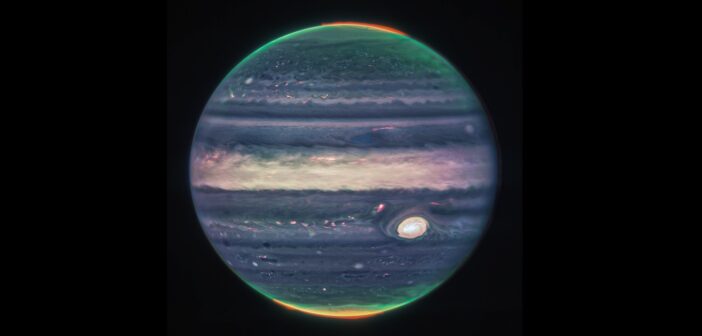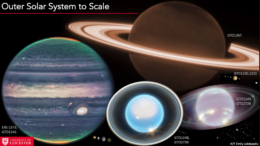Editor’s Note: This week we’ll be writing updates on selected events at the 55th Division for Planetary Sciences (DPS) meeting, held jointly with the Europlanet Science Congress (EPSC) in San Antonio, Texas, and online. The usual posting schedule for AAS Nova will resume on October 9th.
Table of Contents:
- New Solar System Discoveries from the JWST (Stefanie Milam, Lee Fletcher, and Anna Carolina Souza-Feliciano)
- Arm in Arm: Allies in Adversity (Robert Salcido Jr.)
- Press Conference (Lynnae Quick, Jon Zink, Pietro Matteoni, and Gordon Kai Hou Yip)
New Solar System Discoveries from the JWST (by Ben Cassese)
Though JWST was initially conceived to tackle questions involving galaxies, cosmology, and the grand scale of our universe, it has proved a wonderful tool for the planetary sciences as well. One of the plenary sessions on Wednesday was dedicated to advances in our understanding of the solar system enabled by this new observatory, and it was split between three speakers.
First up was Stefanie Milam, the JWST Deputy Project Scientist for Planetary Science, who gave an overview of the investigations already underway with the latest flagship space telescope. Beyond our solar system, JWST has broken records in nearly every subfield of astronomy: it discovered and confirmed the most distant galaxy known to date, revealed an entirely new type of object in the Trapezium Cluster, and imaged rings of protoplanetary disks that had previously gone unseen in the glare of their host stars. Closer to home, it has collected the most detailed spectra of comets ever recorded, detected water vapor around a main belt comet for the first time, and provided never-before-seen views of the planets and their moons. These solar system observations are particularly impressive from a technical standpoint, since they required the ungainly assembly of mirrors and sunshades to move rapidly in order to stay focused on objects as they (and it) move around the Sun. As recently as a decade ago, the JWST science team was told that the telescope would not be able to observe something as bright, extended, and fast as Mars. Thanks to the advocacy of the scientists, the ingenuity of the engineers, and the skill of the project managers, JWST has already out-performed these assumed limitations.
Leigh Fletcher of the University of Leicester came next. He delivered a presentation titled “New Views of the Giant Planets,” and his slides could have been sold as a dazzling coffee table book. Embedded within each of the gorgeous images of the four largest planets bound to our Sun were plenty of scientific “firsts.” These included the first H3+ aurorae found at Neptune; maps of the temperature variations on Uranus; observations of the region around Saturn just as detailed as those taken by the Cassini spacecraft when it was actually there, in orbit; and spectra of Jupiter and its Great Red Spot. Fletcher dedicated a portion of his time to a mention that the moons of these planets hadn’t escaped scrutiny either, and throughout his presentation emphasized that this enormous quantity of high-quality data had been collected in just the first year of operations.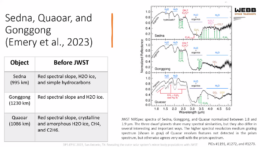
Spectra of Sedna, Gonggong, and Quaoar collected by JWST. [Slide by Ana Carolina de Souza Feliciano]
Arm in Arm: Allies in Adversity (Robert Salcido Jr.) (by Kerry Hensley)
In the final plenary presentation of the day, the Executive Director for the Pride Center San Antonio, Robert Salcido Jr., described the challenges facing the LGBTQ+ community of San Antonio, where the DPS–EPSC conference is being held. The Pride Center serves as a hub for the community and offers free counseling, case management, and group therapy, filling a need for mental health services.
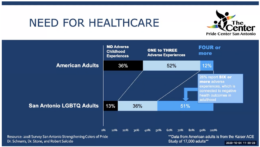
Comparison of Kaiser adverse childhood experience scale results for American adults and LGBTQ+ adults in San Antonio. Click to enlarge. [Slide by Robert Salcido Jr.]
Additionally, the survey revealed ongoing challenges faced by the LGBTQ+ community in San Antonio, especially in healthcare settings; 1 in 10 of the adults surveyed didn’t know where to access affordable or appropriate healthcare, and that number rose to 1 in 4 for transgender respondents. These responses underscored the need for better healthcare — both physical and mental — and was used to inform the structure of the clinical practice at the Pride Center.
Zooming out to look at Texas as a whole, Salcido notes that the state is a “hotbed” for attacks against the LGBTQ+ community. In 2023, about 600 bills were filed statewide that aimed to restrict the rights of people who identify as LGBTQ+, especially when it comes to gender-affirming care. Compare this to 2013, when just 20 bills were filed, none of which passed. In 2021, this rose to 76 filed bills, one of which passed, and in the most recent legislative session, 141 bills were filed. These bills targeted the use of puberty blockers for trans kids, banned trans athletes from competing at the collegiate level, and banned drag shows, to name just a few. In other words, bills are being filed in Texas that seek to exclude transgender people from everyday life — despite the fact that a recent survey from the Trevor Project found that 71% of Texans support the LGBTQ+ community.
Salcido ended his talk by prompting the audience to think about what it means to be an ally in your profession, for your friends, and for your family. Ally isn’t just a noun, it’s also a verb, and action is important — but it may not look the same for everyone. What’s important is showing up in support of communities to which you don’t belong: advocating for LGBTQ+ people, standing against oppression, acknowledging one’s own prejudices, and working to understand what matters to people within the community.
Press Conference (Briefing video) (by Kerry Hensley)
Lynnae Quick (NASA Goddard Space Flight Center) started off the press conference with a presentation on icy ocean exoplanets. Previous research has suggested that Earth-sized terrestrial exoplanets are likely to be ice covered and have subsurface oceans. If these frosty worlds are heated, either through tidal stresses or the decay of radioactive materials, they could be a promising place to look for life beyond Earth. In a new study, Quick and collaborators investigated 17 Earth-sized exoplanets thought to be icy worlds with subsurface ocean. The list of planets includes well-known planets like the outer planets of the TRAPPIST-1 system as well as Proxima Centauri b. Quick’s team constrained the tidal and radiogenic heating rates of these planets, many of which had heating rates greater than Europa and Io. Since Europa and Io are both thought to have subsurface oceans, this suggests that these planets have subsurface oceans as well.

Ice shell thicknesses of some of the exoplanets observed in this study compared to Earth and Europa. Click to enlarge. [Slide by Lynnae Quick]
Jon Zink (California Institute of Technology) took a wide view of planet formation, beginning with the formation of the Milky Way 13 billion years ago. Even as our galaxy was forming from a cloud of gas, planets were forming, too, and the different stages of galaxy formation may have left an imprint on planets forming at each stage. In the first stage, our galaxy formed a thick disk of stars as core-collapse supernovae exploded, spewing gas rich in alpha elements (e.g., oxygen, silicon, and neon; these elements are important for terrestrial planet formation — Earth is 75% silicon and oxygen) into space. Next, a merger with another galaxy created the galactic halo. After that, the solar system formed and a thin disk of stars was created. Around this time, Type Ia supernovae, which arise in binary systems containing a white dwarf, created an abundance of iron, which is thought to provide the seeds for giant planet formation.
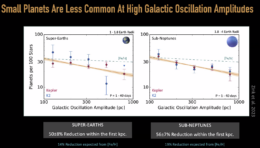
Super-Earth and sub-Neptune exoplanets are less common around stars with large galactic oscillation amplitudes. Click to enlarge. [Slide by Jon Zink]
Pietro Matteoni (Freie Universität Berlin) brought things back to our solar system with a close look at one of the best places to search for life beyond Earth: Jupiter’s moon Europa. Europa has an ice shell, a subsurface ocean, a rocky interior, and a metallic core. Europa is thought to produce plumes of water that carry material from beneath the crust and distribute it on the moon’s surface. However, given the thickness of Europa’s ice shell — likely on the order of kilometers — it’s unlikely that these plumes are carrying material directly from the subsurface ocean. Instead, shallow pockets of water within the ice are probably the source.
Using data from the Galileo spacecraft, Matteoni’s team studied two regions that have surface features that could be associated with shallow water pockets. The first, Mènec Fossae, appears to have been shaped by tectonic activity and contains many features in a small area that could be linked to subsurface activity. In particular, the elevation profiles of certain features match perfectly what is expected if there is a shallow water pocket below. The second region, Thrace Macula, is known to be geologically young and contains material from the moon’s interior. This region is characterized by a tectonic fault, and the fault lines may provide a way to transport material to the surface. Thrace Macula will be observed by the upcoming Juice and Europa Clipper missions, so we’ll soon learn much more about this region! | Presentation slidesGordon Kai Hou Yip (University College London) addressed a pressing question: how can artificial intelligence help us answer questions about exoplanet science? Yip is the Principal Investigator of the Ariel Data Challenge, an event that entices machine learning experts to apply their skills to pressing questions in exoplanet science — in particular, how to relate a planet’s spectrum to its atmospheric properties. This is a critical question given the shift in exoplanet research from finding planets to characterizing them, and many upcoming telescopes — like the European Space Agency’s Ariel mission that is slated to launch in 2029 — will return an immense amount of data that we don’t fully know how to handle yet. Enter machine learning: a set of computing techniques in which computers discover their own algorithms, usually being trained on a “known” set of inputs and outputs before applying the algorithms to new inputs.
Yip suggests that solving these problems will require input from experts in many fields, but it can be challenging to bring people with different areas of expertise together; thanks to field-specific jargon, these researchers aren’t even speaking the same language. The Ariel Data Challenge partners with machine-learning conferences and so far has engaged more than 300 researchers around the world. Researchers form teams and develop machine-learning techniques in an attempt to predict atmospheric properties of exoplanets from spectroscopic data. Based on the results of these challenges, Yip’s team has several takeaways: 1) machine-learning models don’t like surprises, and they don’t perform well when given data that’s outside the bounds of the known parameter space — but that’s exactly where upcoming exoplanet missions will take us; 2) money is important to researchers (the winners of the challenge get a monetary prize), but passion for machine learning and the science of exoplanets is a bigger draw for the challenge participants; and 3) physicists are required to win the game — all the winning teams partnered with researchers who had a background in physics. So don’t worry too much about machines replacing astrophysicists — we’re still critical to making exoplanet investigations a success!

